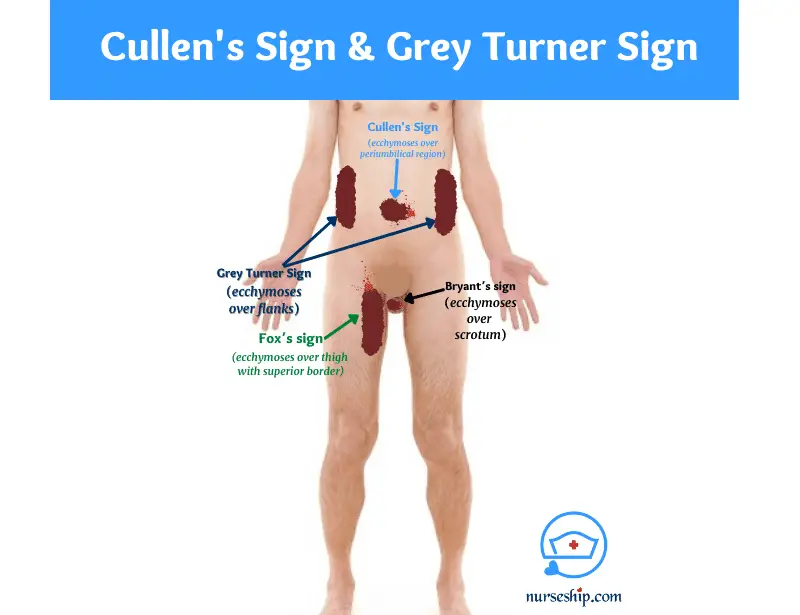Last updated on December 28th, 2023
Grey Turner Sign
Grey Turner sign is classically known as a sign of acute pancreatitis. It is rare but a severe sign often appears along with Cullen’s sign.
Grey Turner sign is characterized by the appearance of purplish-bluish skin discoloration (ecchymosis) on the flanks due to internal bleeding. The color of ecchymosis will vary depending on the extent of RBCs breakdown in the tissues of the abdominal wall. Ecchymosis may appear as a greenish, bluish, purplish, and yellowish,
The Grey Turner sign usually takes 24 to 48 hours to appear on the skin after the internal hemorrhage.
History of Grey Turner Sign
The Grey Turner sign, also known as Turner’s sign, was first reported in medical literature in a 1920 paper named “Local discoloration of the abdominal wall as a sign of acute pancreatitis” by a British surgeon, Dr. George Grey Turner (1877-1951).
According to the paper, he first noticed the sign in 1912 in the case of a 54-year-old female with acute abdominal illness. After her demise, the postmortem revealed necrosis of the tissues due to pancreatic leakage.
He did not come across a similar case until 5 years later in 1917. This time it was a 53-year-old lean male with on and off severe abdominal pain. Some of the additional symptoms include tenderness over the gallbladder, seizure, diaphoresis, tachycardia, abdominal distention, and fever.
Causes of positive Grey Turner sign
- Acute Pancreatitis
- Pancreatic hemorrhage
- Liver abscess
- Malignant diseases such as liver and abdominal metastasis
- Ruptured abdominal aortic aneurysm
- Perforated duodenal ulcer
- Splenic rupture
- Ruptured ectopic pregnancy
- Blunt abdominal trauma

Mechanism of Grey Turner sign
The Grey Turner sign is produced due to an abnormal hole in the abdominal fascia. This defect in transversalis fascia lets the blood from the posterior pararenal space travel to the abdominal wall’s musculature and then to the subcutaneous tissue.
Which results in the appearance of ecchymoses on the flanks area of the abdomen. When the Grey Turner sign is associated with acute pancreatitis, suggests poor patient outcome.
Clinical significance of Grey Turner sign
According to the medical literature, the specificity of Grey Turner sign with regard to acute pancreatitis is very low. Hence, the absence of the Grey Turner sign does not exclude underlying pathology.
Additionally, Grey Turner sign has been documented in cases of retroperitoneal bleeding such as hepatocellular carcinoma, trauma, perirenal hematoma, and portal hypertension.
Nursing consideration in Grey Turner sign
Like Cullen’s sign, Grey Turner sign also indicates the presence of intra-abdominal bleeding, though very specific to pancreatitis.
Therefore, if you notice an ecchymosis (discoloration of the skin due to internal bleeding) at the flank area, ensure to take an in-depth patient history and immediately notify the findings to clinician in charge.
Because the patient requires urgent investigations to rule out the actual cause of bleeding and initiate appropriate treatment as soon as possible.
Other Related Signs
Similar clinical signs reported along with Cullen’s sign and Grey Turner sign due to retroperitoneal hemorrhage and pancreatitis include Fox’s sign and Bryant’s sign.
Fox’s sign is defined as ecchymoses (purplish-bluish skin discoloration due to intra-abdominal bleeding) of the thigh with superior border.
Fox’s sign was named after George Henry Fox (1846-1937), an American dermatologist.
Bryant’s sign is defined as ecchymoses (purplish-bluish skin discoloration due to intra-abdominal bleeding) of the scrotum. This sign is usually associated with a ruptured aortic aneurysm. Bryant’s sign is named after a British physician, Dr. John Henry Bryant (1867-1906).
Reference
Dennis, M., Bowen, W., & Cho, L. (2016). Mechanisms of Clinical Signs (2nd ed.). Elsevier Australia.
White, F. (2009). Physical signs in medicine and surgery. Museum Press.



Comments are closed.